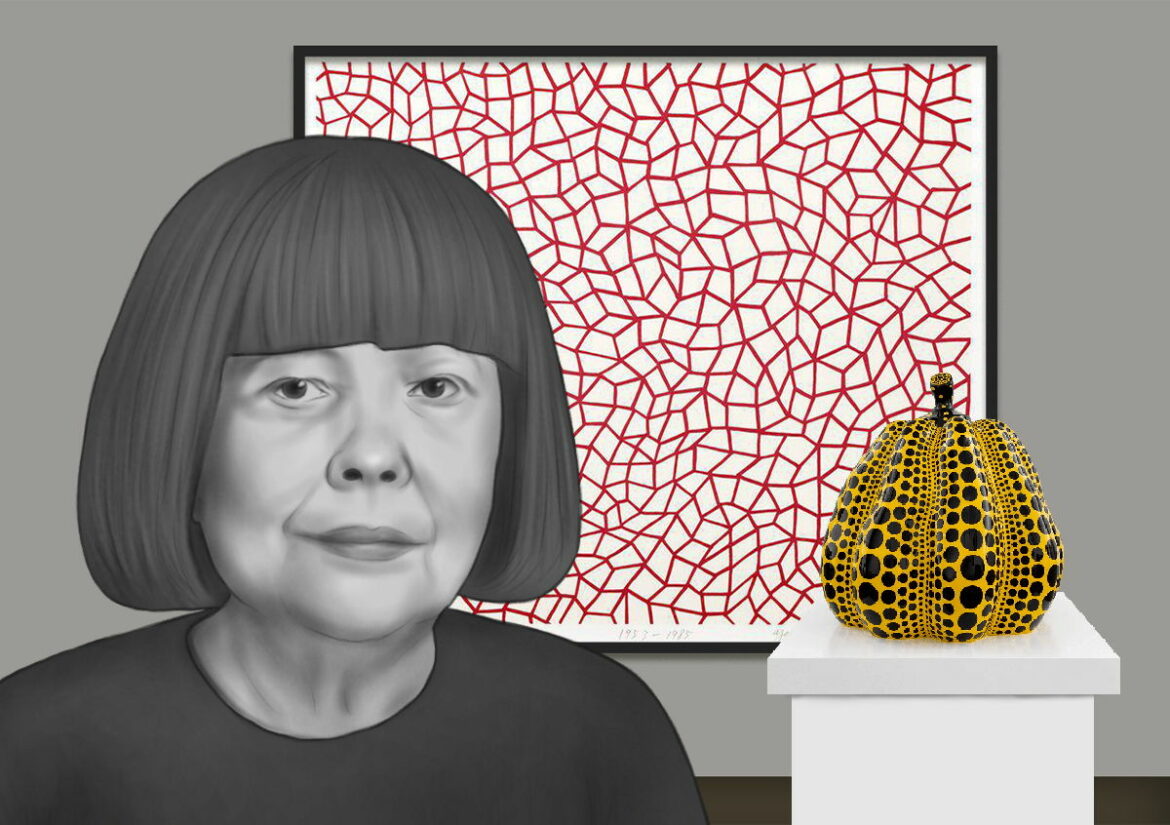Yayoi Kusama is a Japanese artist who has captured the world’s attention with her vibrant, colorful, and polka-dotted installations and sculptures. She is known for her unique perspective on art, using her work as a way to express her personal experiences with mental illness and her ongoing fascination with infinity. Kusama’s work has become so popular that she has been dubbed the “Queen of Polka Dots.” In this article, we will explore Kusama’s life, her artistic vision, and her impact on the art world.
Early Life and Artistic Beginnings
Kusama was born on March 22, 1929, in Matsumoto, Nagano, Japan. She grew up in a wealthy family, but her childhood was not easy. Her parents were distant and emotionally cold, and her father was unfaithful to her mother. As a result, Kusama developed anxiety and depression at a young age. She found solace in art, often creating paintings and drawings as a way to escape her troubled home life.
In 1948, Kusama moved to Tokyo to pursue her artistic ambitions. She enrolled in the Kyoto Municipal School of Arts and Crafts, where she studied traditional Japanese painting techniques. However, Kusama quickly became disillusioned with the school’s conservative approach to art. She wanted to explore new forms of expression that were not bound by tradition.
In 1957, Kusama moved to the United States, where she would spend the next two decades of her life. She settled in New York City, where she quickly became involved in the city’s avant-garde art scene. She began creating large-scale paintings that were filled with polka dots, a motif that would become a signature element of her work.
The Birth of Infinity Nets
In the early 1960s, Kusama began creating a series of paintings that she called “Infinity Nets.” These paintings were created by meticulously painting thousands of small loops and marks on a canvas, creating a sense of infinite depth and space. Kusama saw the Infinity Nets as a way to express her fascination with the infinite and the unending repetition of patterns.
The Infinity Nets quickly gained attention in the art world. Kusama’s work was shown in several exhibitions in New York City, and she began to gain a following of fans and supporters. However, Kusama’s mental health began to deteriorate, and she became increasingly isolated and reclusive. She began to experience hallucinations and delusions, which led to several hospitalizations.
Return to Japan and the Birth of Installations
In 1973, Kusama returned to Japan, where she began to shift her focus from painting to installation art. She began to create immersive environments that were filled with polka dots and other repetitive patterns. These installations were designed to overwhelm the senses, creating a sense of infinity and endlessness that mirrored Kusama’s own experiences with mental illness.
One of Kusama’s most famous installations is “The Obliteration Room,” which was first shown in 2002. The installation consists of a plain white room that is filled with furniture and objects painted entirely in white. Visitors are then invited to cover the entire space with colorful stickers, slowly transforming the room into a vibrant explosion of color and pattern.
Legacy and Impact
Today, Kusama is widely recognized as one of the most influential and innovative artists of the 20th and 21st centuries. Her work has inspired countless artists and designers, and her impact on the art world is immeasurable.
Kusama’s work has also become incredibly popular with the general public. Her installations have been shown all over the world, drawing massive crowds of people who are drawn to the immersive and engaging nature of her work. Kusama’s iconic polka dots have become a symbol of joy, playfulness, and wonder, and her work has helped to redefine the boundaries of contemporary art.
One of the most remarkable things about Kusama’s work is the way it transcends cultural and generational boundaries. Her installations and sculptures have been shown in museums, galleries, and public spaces all over the world, from Japan to the United States to Europe and beyond. Her work has been embraced by people of all ages and backgrounds, from children to seniors, and has become a beloved fixture in the cultural landscape.
Kusama’s influence can be seen in a wide range of artistic fields, from fashion and design to music and film. Her work has been featured in numerous fashion campaigns, and her polka dots have been used as a design element on everything from clothing to furniture to home decor. Her impact on popular culture can be seen in films such as Sofia Coppola’s “Lost in Translation,” where Kusama’s iconic “Infinity Mirrored Room” makes a cameo appearance.
In recent years, Kusama’s work has also become a source of inspiration for social media influencers and digital artists. Her colorful and playful installations have been shared widely on Instagram and other social media platforms, often accompanied by inspiring quotes and messages of hope and positivity.
Conclusion
Yayoi Kusama’s impact on the art world cannot be overstated. Her unique artistic vision, which combines elements of traditional Japanese art with avant-garde techniques, has helped to redefine the boundaries of contemporary art. Her polka dots, Infinity Nets, and immersive installations have become iconic symbols of joy, wonder, and infinite possibility.
Kusama’s ongoing struggles with mental illness have also been an important part of her artistic journey. Her work has helped to raise awareness of mental health issues and to break down the stigma surrounding mental illness. Kusama has shown that art can be a powerful tool for healing and self-expression, and her legacy will continue to inspire generations of artists and art lovers for years to come.
The article was written for you by the editor-in-chief of the Bestcasinosincanada.net – Jeff Vertes.
